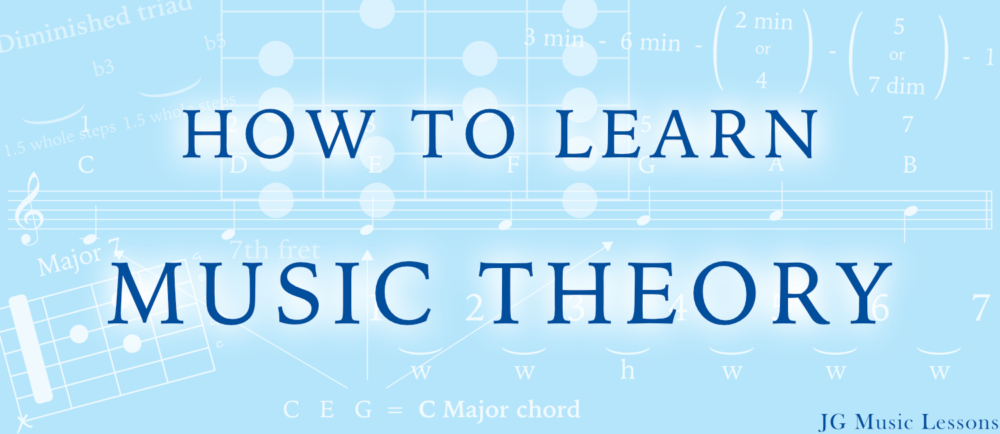Music theory is the foundation of music, and it can help you improve your playing, songwriting, and overall understanding of music.
If you’ve been trying to wrap your head around trying to understand music theory but the process seems complicated or you don’t know where to start, this guide will give you an overview on music theory, from the basics to more advanced concepts.
Although this is aimed primarily for guitar players, all these concepts can be applied to other instruments. Let’s get started!
What is music theory?
Music theory can be summed up as the principles to help us understand how and why things work in music. Music theory includes concepts related to melody, harmony (chords), and rhythm.
Although it is considered theory, which means the ‘rules’ can and do get altered, there are some essential concepts that we can learn to better help us understand how music works.
Let’s get started with the basics.
How many notes are there?
Before we get started talking about different concepts, we first have to understand all of the notes that are used in music. The western music system uses 12 notes which are C, C#, D, D#, E, F, F#, G, G#, A, A#, and B. (#) represents a sharp which means a note is moved a half step up.
C# would be said C sharp.
You also have flats represented by the symbol (b) which means a note is moved a half step down.
Db would be said D flat.
This means that C# and Db are the same note, but simply named differently.
Here are each of the 12 notes a half step apart:

You can check out the 7 tips to learn all of the notes on the guitar fretboard if you don’t know them already.
These 12 notes are where all the melodies you hear come from. However, most melodies that you hear in music usually come from a more organized set of notes which we call scales.
How do scales work?
In music, a scale has a specific set of notes which we can use to create melodies and are also where chords are built from (more on this later).
First, you have to understand that there are specific distances between each of the notes in a scale. The distance is either a half step apart or a whole step (which is the same as two half steps).
For example:
C to C# is a half step apart.
C to D is a whole step apart.
There are two foundational scales you need to start with which are the Major and minor scale.
Let’s go over the scale formulas:
Major scale formula
The numbers represent each scale degree. The 1 is called the root note.
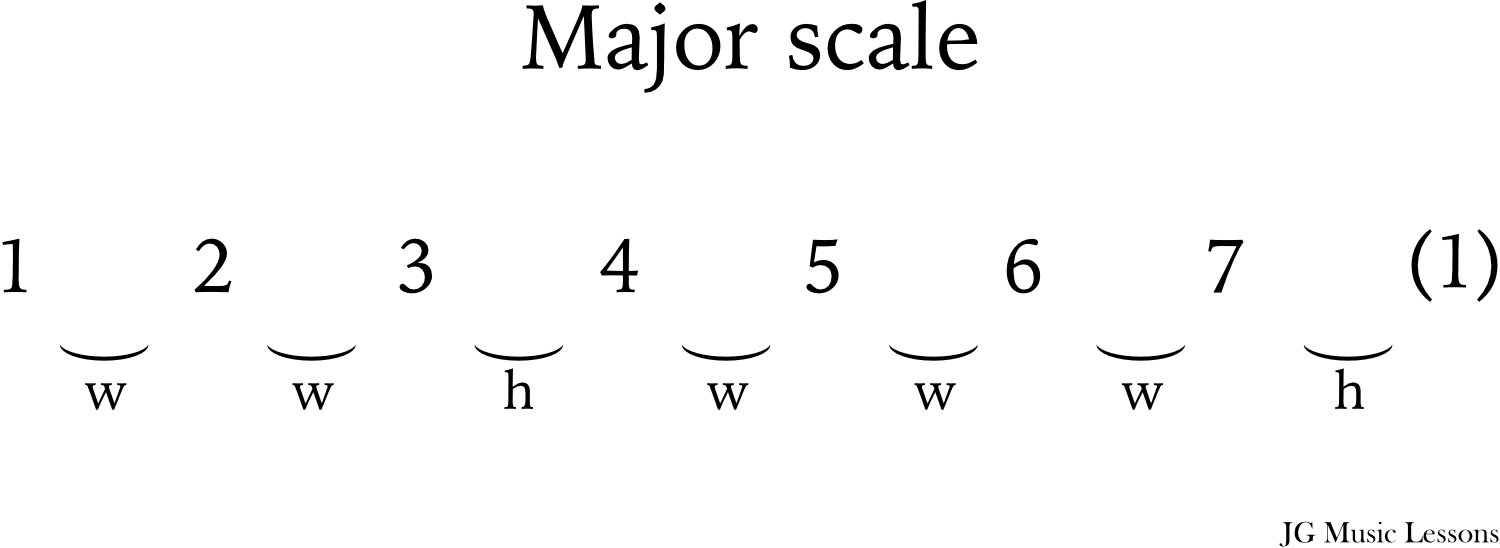
Here are the notes for all the Major scales in the chart below.
| Major scale | 1 | 2 | 3 | 4 | 5 | 6 | 7 |
|---|---|---|---|---|---|---|---|
| C Major scale | C | D | E | F | G | A | B |
| D Major scale | D | E | F# | G | A | B | C# |
| E Major scale | E | F# | G# | A | B | C# | D# |
| F Major scale | F | G | A | Bb | C | D | E |
| G Major scale | G | A | B | C | D | E | F# |
| A Major scale | A | B | C# | D | E | F# | G# |
| B Major scale | B | C# | D# | E | F# | G# | A# |
| Db Major scale | Db | Eb | F | Gb | Ab | Bb | C |
| Eb Major scale | Eb | F | G | Ab | Bb | C | D |
| Gb Major scale | Gb | Ab | Bb | B | Db | Eb | F |
| Ab Major scale | Ab | Bb | C | Db | Eb | F | G |
| Bb Major scale | Bb | C | D | Eb | F | G | A |
I recommend checking out this other lesson on how to play the 5 Major scales shapes on the guitar if you don’t know them already.
Minor scale formula
If you start a Major scale on the 6th degree and end on the 6th again, you are essentially playing a minor scale. For example, an A minor scale shares all the same notes as a C Major scale. An A minor scale has the notes: A, B, C, D, E, F, and G. Another way you can think about playing a minor scale is using this formula here below.
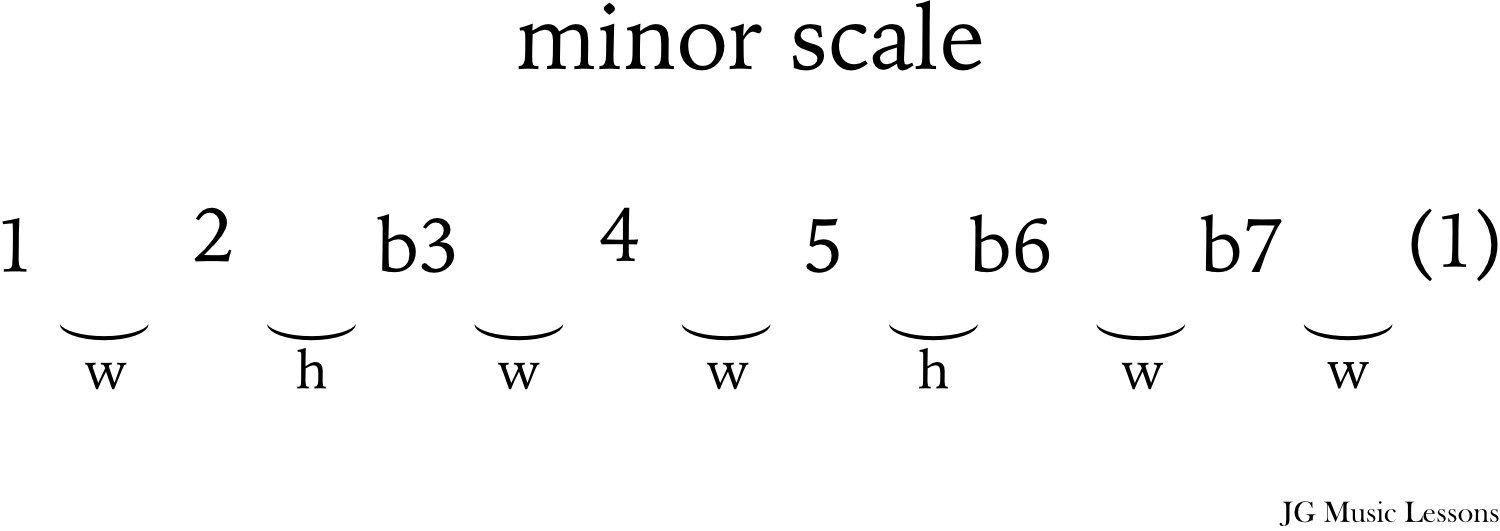
Here are all the notes for every minor scale.
| Natural minor scale | 1 | 2 | b3 | 4 | 5 | b6 | b7 |
|---|---|---|---|---|---|---|---|
| C minor scale | C | D | Eb | F | G | Ab | Bb |
| D minor scale | D | E | F | G | A | Bb | C |
| E minor scale | E | F# | G | A | B | C | D |
| F minor scale | F | G | Ab | Bb | C | Db | Eb |
| G minor scale | G | A | Bb | C | D | Eb | F |
| A minor scale | A | B | C | D | E | F | G |
| B minor scale | B | C# | D | E | F# | G | A |
| Db minor scale | Db | Eb | E | Gb | Ab | A | B |
| Eb minor scale | Eb | F | Gb | Ab | Bb | B | Db |
| Gb minor scale | Gb | Ab | A | B | Db | D | E |
| Ab minor scale | Ab | Bb | B | Db | Eb | E | Gb |
| Bb minor scale | Bb | C | Db | Eb | F | Gb | Ab |
By learning Major scales you essentially learn minor scales as well because they contain the same notes. For more on this, see this lesson on how to play minor scales on guitar.
Key signatures
A key signature is a symbol used in music notation to define the tonality of a piece of music and indicate the notes in a scale. Each key signature has a different amount of accidentals (sharp or flat notes) that define its scale. Instead of having to write a sharp or flat note every time it comes up, you can define this change throughout a piece of music using a key signature.
Every Major key signature has a relative minor key signature that shares the exact notes.
Here is an example below of key signatures that use sharp accidentals.

To learn more, see this simple guide to understanding key signatures.
Chords
The first basic chord structure to learn are triads which are made up of three notes. The distance between the three notes of a triad create different structures such as Major, minor, diminished or augmented chord qualities.
For a basic overview on triads, check out this lesson: What are triads and how do you play them on guitar?
Major triad chords
The Major triad chord is built from the 1st, 3rd, and 5th degrees of a scale.
For example, a C Major triad includes the notes C, E, and G.
Here is the Major triad chord formula is in terms of distance between each note.

Here are some more examples of notes in different Major triads below.
| Major triad chord | 1 | 3 | 5 |
|---|---|---|---|
| C Major | C | E | G |
| G Major | G | B | D |
| E Major | E | G# | B |
| B Major | B | D# | F# |
| Gb Major | Gb | Bb | Db |
You can check out this lesson on how to practice Major triads on guitar.
Minor triad chords
The minor triad chord is built from the 1st, flat 3rd, and 5th degrees of a scale.
For example, a C minor triad has the notes C, Eb, and G.
The only difference with the minor triad is that you lower the 3rd by a half step.
Here is the minor triad chord formula in terms of distance between each note.
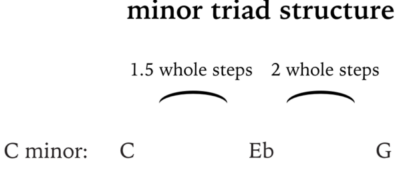
And here is a chart of minor triad chord examples.
| Minor triad chord | 1 | b3 | 5 |
|---|---|---|---|
| C minor | C | Eb | G |
| G minor | G | Bb | D |
| E minor | E | G | B |
| B minor | B | D | F# |
| F# minor | F# | A | C# |
You can check this lesson to learn how to play minor triads on guitar.
Whenever you play open chords, you will find that many notes get repeated even though there are only 3 notes. For example, take a look at this E minor chord with the names of each note on the side of the chart where the root note is repeated 3 times.
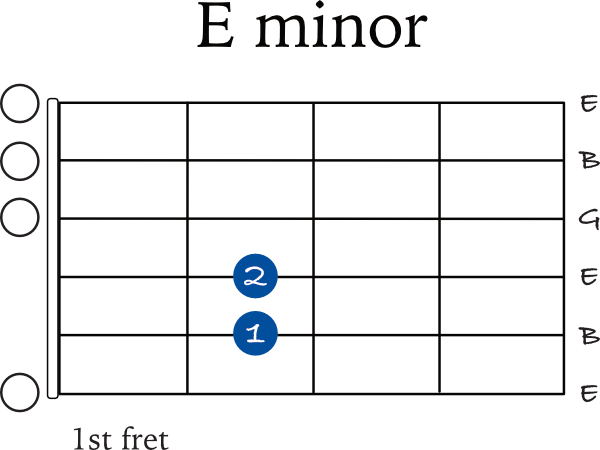
I recommend learning to play chords in many different areas of your instrument so that you can have more musical freedom when playing. For example, there are at least 6 different ways to play Major chords on the guitar. Knowing basic music theory about triads will help you to learn new ways of playing a chord.
Diminished triad chords
Another chord quality that is less commonly used in popular music is the diminished triad chord.
A diminished triad has the chord tones 1, b3, and b5.

See the chart for diminished triad chord examples.
| Diminished triad chord | 1 | b3 | b5 |
|---|---|---|---|
| C diminished | C | Eb | Gb |
| G diminished | G | Bb | Db |
| E diminished | E | G | Bb |
| B diminished | B | D | F# |
| Gb diminished | Gb | A | C |
Don’t worry too much about these chords if you’re still mastering your Major and minor chords. However, it’s still good to be aware of how the diminished triad structure works.
Once you are more confident knowing the basic chords, you can look further into diminished chords.
Augmented chords
Augmented triads have the chord tones 1, 3, and 5#. These chords are commonly used as passing chords. See the formula for these chords below.
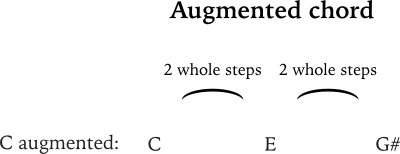
Here some examples of augmented chords below.
| Augmented triad chord | 1 | 3 | 5 |
|---|---|---|---|
| C augmented | C | E | G# |
| G augmented | G | B | D# |
| E augmented | E | G# | C |
| B augmented | B | D# | G |
| Gb augmented | Gb | Bb | D |
You can check out this lesson on how to play augmented chords on guitar.
7th chords
7th chords are taking the triads one step further and adding another chord tone to the structure of the chord. A 7th chord has the following chord tones: Root (1st), 3rd, 5th, and 7th.
By moving some of the 3rd, 5th, and 7th chord tones by a half step, you can build different kinds of 7th chords.
For example:
| 7th chords | Chord tones |
|---|---|
| Major 7 chord | 1, 3, 5, 7 |
| Dominant 7 chord | 1, 3, 5, b7 |
| Minor 7 chord | 1, b3, 5, b7 |
| Half diminished 7th chord | 1, b3, b5, b7 |
You can check out this lesson on the essential 7th chords which includes chord charts and audio examples to help you learn and apply them.
If you’re interested in improvisation, check out how to play Major 7 arpeggios, Dominant 7 arpeggios, minor 7 arpeggios or half diminished chords on guitar.
Understanding what these chords are will help you create and play over chord progressions. For example, here is a chart of all the related chords in every key.
Rhythm
It’s essential to understand the note values and how long each note lasts. Here are some examples:
Note values and durations
| Note value | Beat duration (in 4/4 time) |
|---|---|
| Whole note | 4 |
| Half note | 2 |
| Quarter note | 1 |
| 8th note | 1/2 |
| 16th note | 1/4 |
| 32nd note | 1/8 |
Time signatures
A time signature simply means a specific time grid that is used to notate a melody, chords, and other musical elements.
There are 3 common time signatures used in music which are:
- 4/4 time, which means there are 4 quarter notes in one measure.
- 3/4 time, which means there are 4 quarter notes in one measure.
- 6/8 time, which means there are 6 eighth notes in one measure.
To learn more, refer to this simple guide to understanding time signatures.
Keep notes to learn and review
Whenever you learning anything new or whatever concept you’re trying to understand better, make sure to take notes so that you can always review and pick up where you left off.
I remember keeping journals during my time at music school simply trying to keep up with everything I was working on whether that was practicing scales, learning musical vocabulary, working on improvisation, or learning songs.
Here are some other things you can start doing to improve your understanding of music theory.
Guitar scales PDF worksheet
Since we use scales for many different aspects of music such as playing melodies, riffs, or for improvisation, it is very beneficial to know them thoroughly. To make the process of learning scales easier, I put together a printable fretboard PDF chart practice filling out scales.
You can also use it to write out triads, chords, and other music theory concepts that we covered here on your own time.
Applying music theory to your instrument
If you don’t apply music theory to your instrument it simply becomes head knowledge. It’s important to personalize new material by coming up with your own ideas of a particular concept so that it sticks.
For example, if you working on learning scales you can try to change the order of notes in a scale (see how to practice scales lesson) or explore playing them over different rhythms. Another example is to try writing a melody with a particular scale that you are learning or try playing a melody you know in a different key.
If you working on learning chords, try coming up with a series of chords that might sound good over a melody that you came up with. You can also think about different chord variations you can use to make the harmony sound more interesting.
The key is to challenge yourself to come up with ways of applying the material that you’re learning.
Practice ear training
Another effective way to learn music theory is by listening. Listening takes you from an intellectual understanding of a musical concept into an experiential connection.
What do you hear happening in a melody or riff that you really enjoy and how could you apply some of those elements to your instrument? One of the best things you can do to improve on your instrument is to transcribe great music and artists.
Transcribing means to write down the music you hear in order to analyze it and recreate your own ideas. See this post on how to develop ear training to play what you hear for more on this.
Also, try coming up with melodies or riffs that sound good to you. If are having a hard time with that, try humming out the notes and then match them on your instrument. You will improve the connection between what you hear and how to play it on your instrument.
You may also want to check out this lesson on how to learn to play music by ear.
Follow a method plan, book or course
Because music theory can be such a large subject to tackle, it would be ideal to follow a trusted method plan, book, or course that takes you on a linear learning path. The idea is to have an overall idea of the basic music concepts so that you can actually understand what you are playing and how to use the theory to your advantage.
If you try to get ahead of yourself to learn more advanced topics without mastering the basics, learning music theory can get confusing and frustrating. It’s good to take your time learning one concept well and applying the information to your instrument.
A great site I recommend to get started with learning music theory is musictheory.net. There are many lessons, exercises, and tools to help you get better at music theory. I think some of the games they include to learn the notes on the fretboard are very useful for learners and which I personally recommend to students.
Here is an image of what that game looks like:
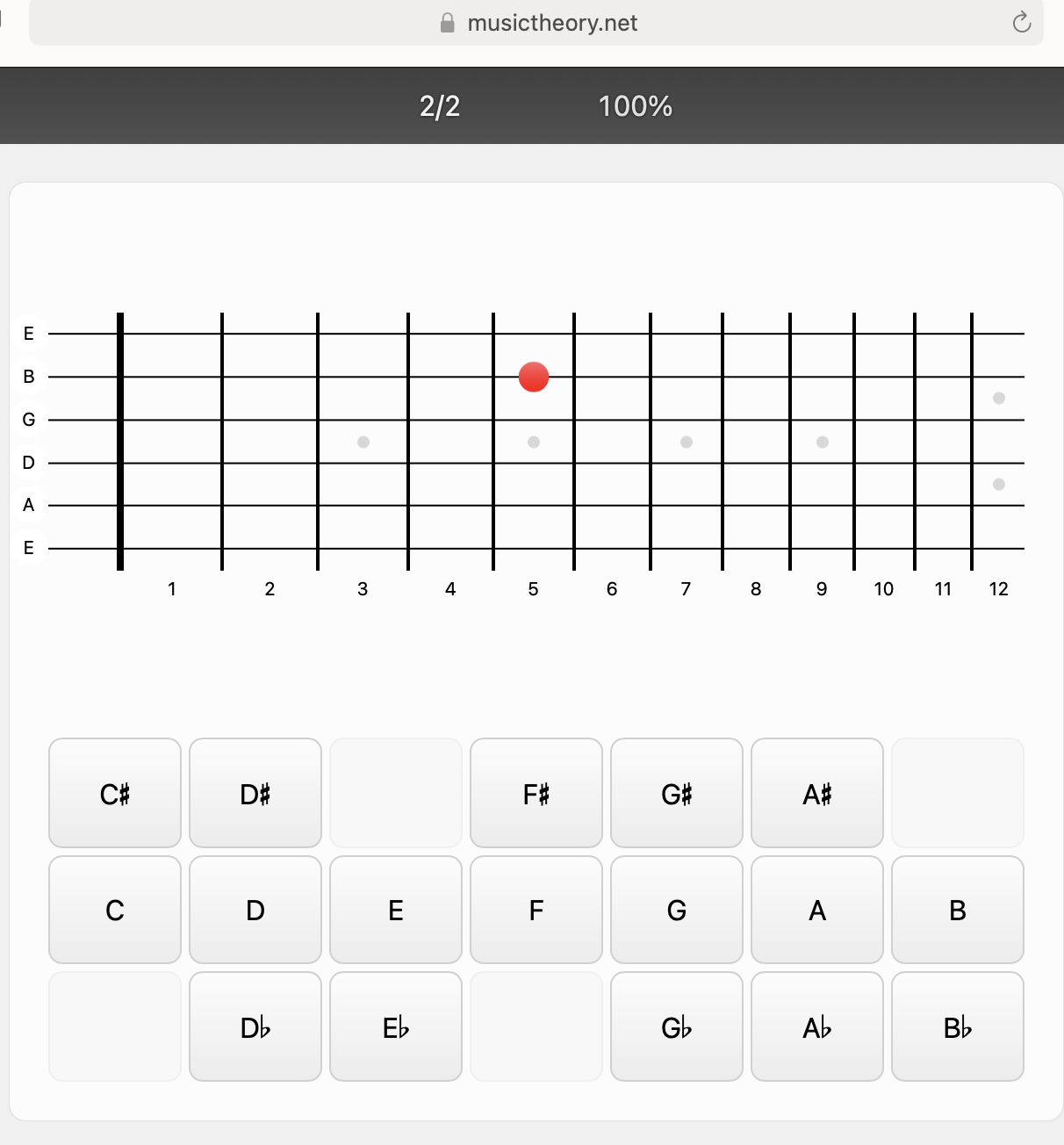
Test your theory skills with our music theory quiz!
Wrapping up
In this lesson, we highlighted some of the essential concepts to learning music theory. It can feel overwhelming to try learning everything at once, so take each concept one at at time before moving on to the next thing.
Remember that applying music theory on your instrument is just as important as the information itself.
Learning music theory helps you become a well rounded musician because you have a clearer understanding of how to approach different musical situations.
📘 Get the free guitar practice guide here!
All the best,
JG Music Lessons
📙 Kickstart your guitar playing with our step by step guide: Guitar Essentials.
🎸 Looking for a travel or half-sized guitar? See this one.
🛠 See our other music recommendations.
🤝 Support the site to help us to create better content for you!
Level up with the FREE guitar practice guide and effectively improve your playing! 🎸
Get it sent to your email!

